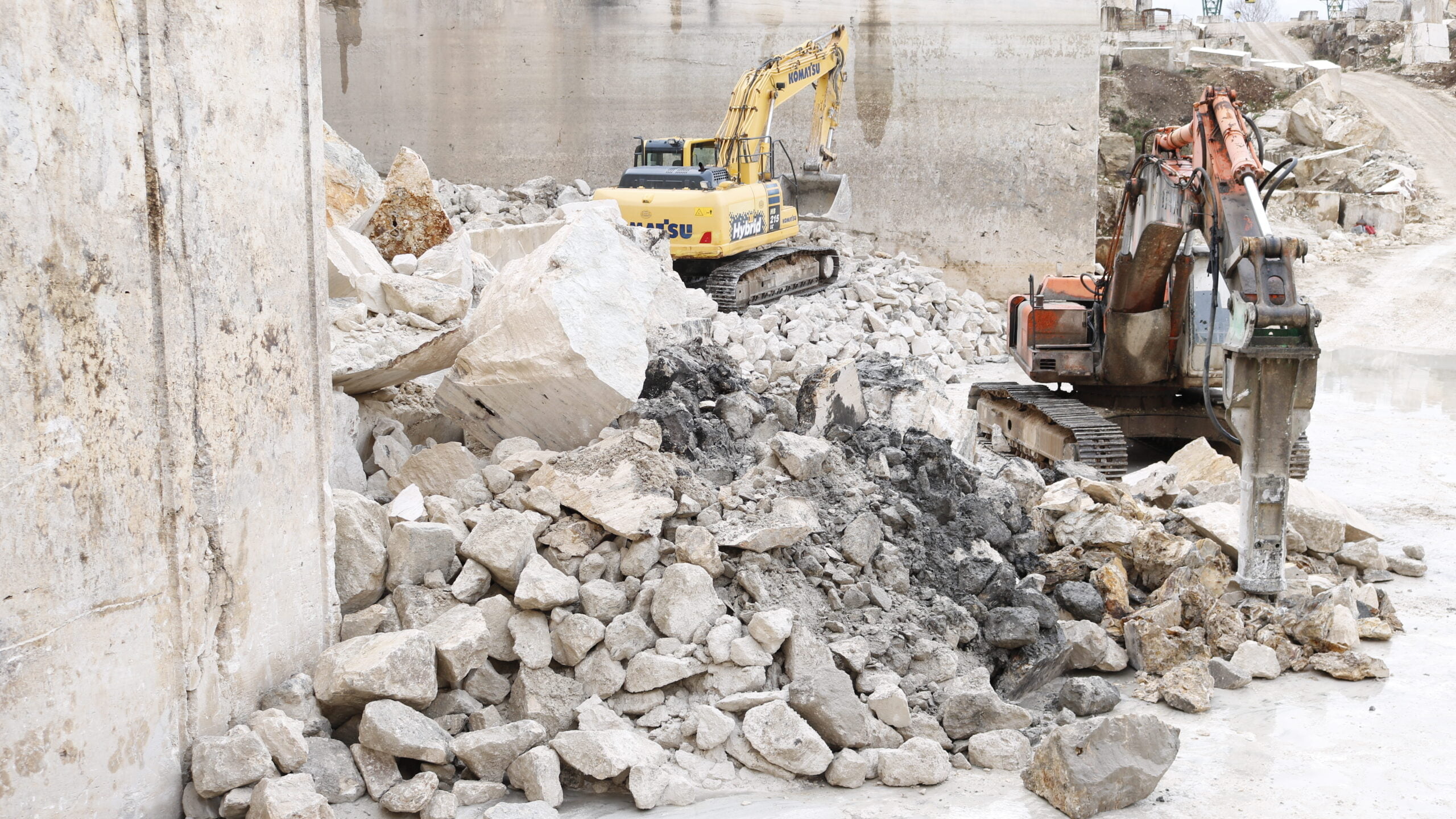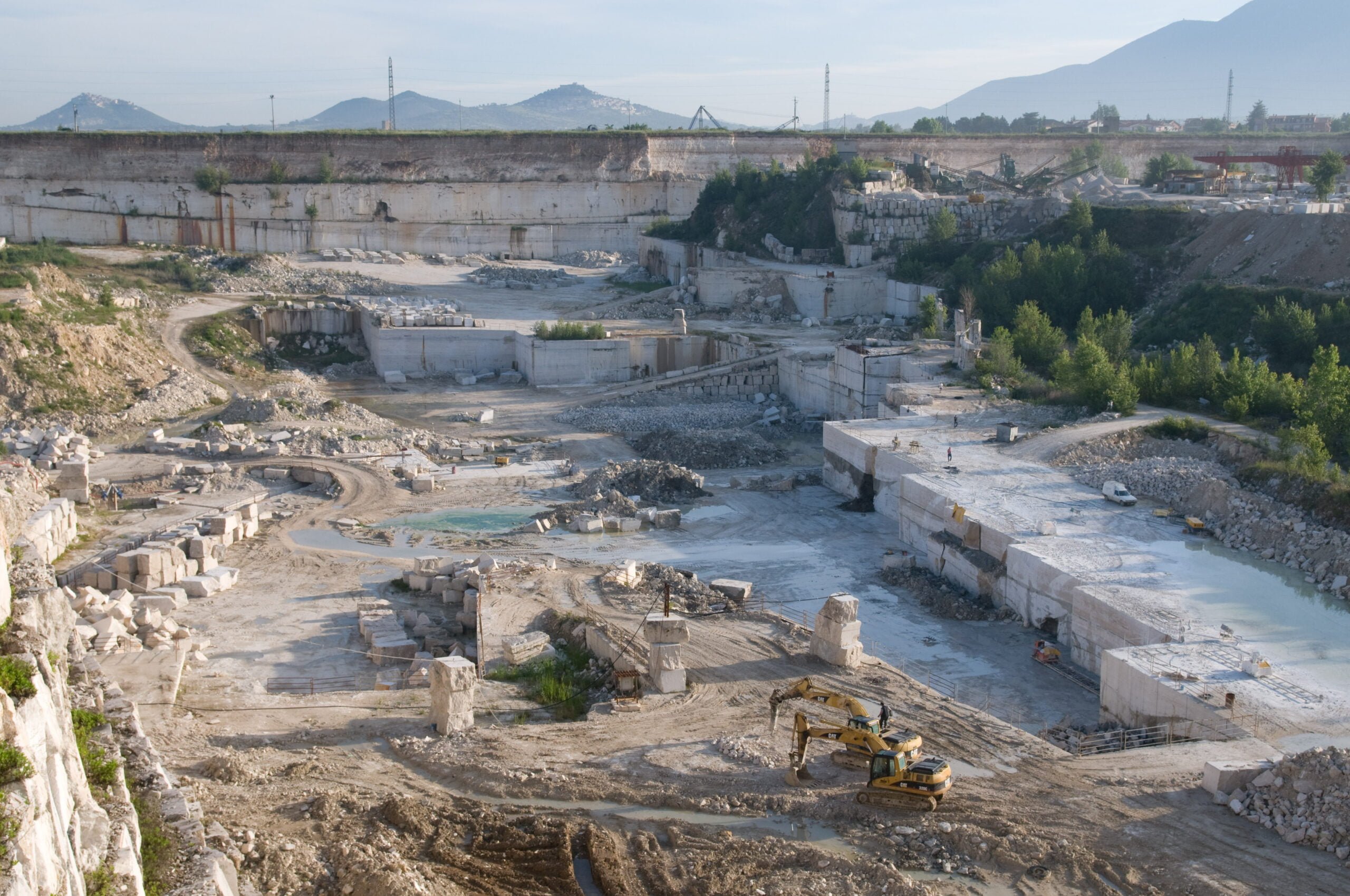Barco Quarries: the Roman Travertine Quarries in Tivoli
The most ancient travertine quarries are the Barco quarries (Cave del Barco, in Italian) in Tivoli, Rome. The precious deposit of Italian travertine was discovered by Romans during the 3rd century b.C. More precisely, the quarries extend to the slopes of Tivoli – Tibur, in Latin. Actually, the natural stone takes its name from the city’s one, as it was originally called Lapis Tiburtinus, or “the stone from Tivoli”. Moreover, for a long time the same quarries were called lapidicina, with a clear reference to the word lapis – stone, in English.
The roman travertine extracted from the Barco quarries is made of calcareous sediments that formed in Pleistocene (that is to say more than 100.000 years ago). The process of formation of this natural stone required tens of thousands of years for the sedimentation and stratification of minerals mainly consisting of calcium carbonate. The hot thermal springs, where the formation process took place, are made of sulphureous waters, also called aquae albulae. Their benefits for the health were known to Romans, that all around the quarries built thermal structures. Among these, the ones in Tivoli Terme are still in use today.

Ager Tiburtinus, the first “name” of the quarry
The first name for the travertine quarries in Tivoli was Ager Tiburtinus. Actually, with this name Romans meant the valley below Tivoli as a whole. The extraction area was delimited by a road, Via Tiburtina, and a river, the Aniene. Both of them were used to carry the blocks of travertine. Ox-drawn wagons went back and forth, from Tivoli to Rome. Instead, wooden rafts carried the blocks using the force of the river current. Hadrian’s Villa, for instance, was erected taking advantage of this system, as it is located near the Aniene river bank.
Following the mining technique in use back then, blocks were cut off of the rock wall with the help of a pickaxe. Cracks on the surface of the stone were filled with wooden wedges and chisels. This made the extraction process faster.
The massive use of roman travertine is proven by many monuments built in Rome, such as Marcellus Theater, Porta Maggiore, Temple of Claudius, and the Colosseum. Nevertheless, structures of functional value (like aqueducts) and architectural elements (like columns, thresholds, jambs, and architraves) were made out of roman travertine too. Moreover, travertine bricks were used to erect buildings with solid foundations. According to the opus quadratum, they were arranged in groups of four. Examples of these applications of the travertine from Rome can be found both in the capital of the empire and the luxurious villas in the countryside. In Tivoli, for instance, examples of creative use of roman travertine are the temples at the Acropolis and mausoleums, like the one of Plauzi family (an important ancient roman family).

What does Barco stand for?
Following the fall of the Roman Empire, the use of the quarries was drastically reduced, until its complete abandonment. The extraction process, in fact, was considered too expensive and time-consuming. However, this didn’t mean that the request of roman travertine for construction purposes dropped too. On the contrary, during the Middle Ages people began to reuse the travertine that was previously extracted. This caused, unfortunately, major damages to ancient buildings and monuments.
Soon the quarry area turned into a swamp due to the constant floods of Aniene river.
It was not until the XVIth century that the extraction activity was restored, following the interest of the Roman Church. In fact, the construction works for building Saint Peter’s Basilica had just started. As proven by Saint Peter’s Colonnade, in this project roman travertine was profusely used with spectacular results.
Meanwhile, the new governor of Tivoli, the Italian cardinal Ippolito II d’Este, turned the ager tiburtinus into his personal hunting reserve. For this reason, the area was renamed Parco (literally park, in English) or, rather, Barco. With this name, people began to refer to the quarry area too, that became for everyone the Barco quarries.
Ever since the most ancient roman travertine quarries, the Barco quarries in Tivoli, have never stopped working. Indeed, it has experienced increasing interest for its technological development. Major changes were made, for instance, in transportation and extraction procedures. At the end of the 19th century, the rails for the tramway that connected Tivoli with Rome were built. It was now possible to replace ox-driven carriages with special wagons for travertine block shipping. Moreover, in the early 20th century the use of helical wire moved by pulleys was introduced in the quarry. It allowed a faster, more accurate, and definitely less tiring outcrop of the bench from the stone wall.
Present & Future
Modern roman travertine quarries are located in the Barco Region. Originally, these land fields were intended for agriculture. In fact, for generations they belonged to the Poggi family, who cultivated them. As travertine deposits were unheated, the fields were transformed into quarries. This is how the story of the Poggi Brothers and their family business began in 1923.
In the early XXth century travertine industry saw a rise in raw material demand. Roman travertine was requested both for construction and decoration purposes. Just to mention a few, with Poggi Bros’ Travertine the fountain at Palazzo del Quirinale, and the EUR district, both in Rome, were erected in the 1940s.
Since the Sixties we operate worldwide. So far we have collaborated with renowned architects and have taken part in many important international projects. Just to name a few: Bank of China in Beijing, the Apple’s Inc. headquarters in Seattle, and the Centre International de Conférences in Algiers.
Clearly, the investment to fund innovations in manufacturing has never stopped. Currently in our quarries diamond wires are in use. These modern natural stone cutting procedures are extremely resistant and sink into the rock separating the single bench from the stone wall easily. State-of-art machinery operating both in our quarries and laboratories to produce blocks, slabs and cut to size pieces are guaranteed by Made in Italy quality.
Our latest challenge is represented by our company’s transformation into industry 4.0. We aim for the future in our field. In other words, we aim at the automation of some production processes, that require also the interconnection of machinery, and data collection in order to achieve the highest levels of production. We hope that this way we can give more emphasis to dexterity and experience of our travertine masters.

Sustainability
In an article like this aimed at retracing the history of roman travertine quarries in Tivoli, it is equally important to mention the increasing attention paid to the territory, where the mining activity takes place. Nowadays, in fact, quarry owners and mining companies are subject to a whole series of rigid controls and obligations under the law both for opening and closing a quarry. For instance, every time a deposit of raw material from the subsoil runs out, the mining company is obliged to fill the now empty space with non-polluting rocks. This is what in the jargon is called “mine backfilling” and it helps rebuild the original natural landscape of the area.
A special thanks goes to Dr. Zaccaria Mari for his interesting and detailed essay. Barco quarries, “La cava del Barco e la piana delle Acque Albule nell’antichità”, 2002.



Follow Us On Social Media: